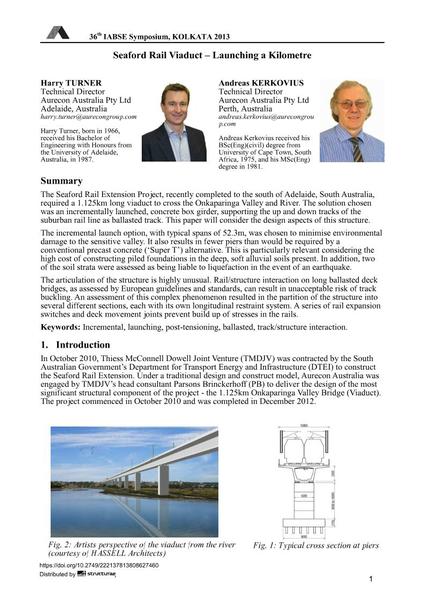Seaford Rail Viaduct – Launching a Kilometre

|
|
|||||||||||
Détails bibliographiques
| Auteur(s): |
Harry Turner
Andreas Kerkovius |
||||
|---|---|---|---|---|---|
| Médium: | papier de conférence | ||||
| Langue(s): | anglais | ||||
| Conférence: | IABSE Symposium: Long Span Bridges and Roofs - Development, Design and Implementation, Kolkata, India, 24-27 September 2013 | ||||
| Publié dans: | IABSE Symposium Kolkata 2013 | ||||
|
|||||
| Page(s): | 1-8 | ||||
| Nombre total de pages (du PDF): | 8 | ||||
| Année: | 2013 | ||||
| DOI: | 10.2749/222137813808627460 | ||||
| Abstrait: |
The Seaford Rail Extension Project, recently completed to the south of Adelaide, South Australia, required a 1.125km long viaduct to cross the Onkaparinga Valley and River. The solution chosen was an incrementally launched, concrete box girder, supporting the up and down tracks of the suburban rail line as ballasted track. This paper will consider the design aspects of this structure. The incremental launch option, with typical spans of 52.3m, was chosen to minimise environmental damage to the sensitive valley. It also results in fewer piers than would be required by a conventional precast concrete (‘Super T’) alternative. This is particularly relevant considering the high cost of constructing piled foundations in the deep, soft alluvial soils present. In addition, two of the soil strata were assessed as being liable to liquefaction in the event of an earthquake. The articulation of the structure is highly unusual. Rail/structure interaction on long ballasted deck bridges, as assessed by European guidelines and standards, can result in unacceptable risk of track buckling. An assessment of this complex phenomenon resulted in the partition of the structure into several different sections, each with its own longitudinal restraint system. A series of rail expansion switches and deck movement joints prevent build up of stresses in the rails. |
||||
